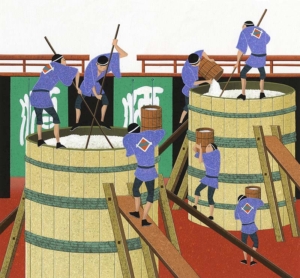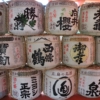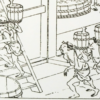How to Japanese sake brewing , Introducing all 12 processes in an easy-to-understand manner
How to Japanese sake brewing , Introducing all 12 processes in an easy-to-understand manner
Despite the fact that sake is traditional Japanese sake, there are surprisingly few people who know in detail how to make it.
The reason is that the method of brewing sake is complicated and difficult to understand.
However, sake is made by a method unique to sake that is not found in other ways of making sake! If you know how to make sake, you should be able to drink sake even more deliciously!
For beginners of sake, I will introduce how to make sake with illustrations. You can understand the basic knowledge of how to make sake just by reading this page.

Contents
① 精米 SeiーMai(Rice polishing)
② 洗米・浸漬 SenーMai・Shinseki (Rice washing・Soaking)
③ 蒸米 MushiーMai (Rice steaming)
④ 麹づくり KojiーZukuri (Koji making)
⑤ 酒母づくり ShuboーZukuri (Yeast starter)
⑥ 仕込み・もろみ Shikomi・Moromi (Preparation・Fermentation mash)
⑦ 搾り Shibori (Squeeze)
⑧ 濾過 Roka (filtration)
⑨ 火入れ Hiire ( Pasteurization)
⑩ 貯蔵 Chozo (Storing)
⑪ 調合 Chougo (Formulation)
⑫ 瓶詰め BinーZume (Bottling)
“Sweet" and “dry" vary depending on how you make it.
“Raw materials" and “people" that are indispensable for making delicious sake
Summary
① 精米 SeiーMai(Rice polishing)
In our process, we will scrape the rice.
And, there are chain glycolipids and proteins of rice, and these consist of a miscellaneous taste with the table.
Shaving rice is called “polishing" in the sake process.
Brown rice Brown rice is white rice brown rice.
As anyone who has eaten brown rice knows, it has a unique flavor.
If you try to make sake without shaving the rice, the aroma will be strong and some people will feel a bitter taste, just like the difference between brown rice and white rice. In other words, it has a unique taste.
This is called “miscellaneous taste" and is not something that is generally unnecessary for sake with a delicate taste.
Sake is polished more than regular white rice to further eliminate the unpleasant taste. If you look at the label of sake, you can see how much it has been scraped.
The notation such as “○% polished rice" is called the rice polishing rate, which indicates what percentage of the rice is compared to brown rice.
In other words, in the case of 60% polished rice, 40% was cut.
To put it plainly, the smaller the rice polishing rate, the more polished it is. Considering that white rice is about 90% polished, while sake generally cuts 70% or more, you can see how delicate the taste is emphasized in sake.
Some sake is made without polishing rice so that you can enjoy the depth of the rice, but it has a strong habit and is for those who have mastered sake. Sake that has been polished a lot is cleaner and easier to drink, so if you are new to sake, please use this as a reference when choosing.
In summary, sake is more polished than white rice to adjust the taste because the ingredients on the outside of the rice, which have a miscellaneous taste, are reflected in the taste more than ordinary rice.
② 洗米・浸漬 SenーMai・Shinseki (Rice washing・Soaking)
After polishing the rice, wash it with water and soak it in water.
After polishing, the rice has shavings, so wash it off with water. The reason for soaking in water is to allow the rice to absorb the water.
The rice we eat is also soaked in water for a certain period of time so that the core does not remain, and then cooked. This is the same theory.
In the case of sake rice, the rice is steamed in the next process, so it absorbs water. By the way, sake brewing is more delicate than rice in terms of water absorption time.
- If the water absorption time is short, the rice will not be sufficiently steamed due to lack of water.
- It has a long water absorption time and melts too much during the fermentation process of moromi mash.
As mentioned above, it fails whether it is short or long.
Not only that, the optimum water absorption time for delicious sake brewing is not always constant, which is a deep point of sake brewing. If the temperature is low, it will be difficult for water to soak in, and the amount of water that can be absorbed differs depending on the type of sake rice.
In other words, the soaking time is changed in seconds depending on the climate and temperature at that time and the variety of sake rice to absorb an appropriate amount of water.
③ 蒸米 MushiーMai (Rice steaming)
Rice containing an appropriate amount of water is steamed in a large kettle called 甑 Koshiki(steaming vat).
This is where it is steamed with zeal.
By steaming, it becomes more susceptible to the action of “Rice Malt", which is the subsequent process. It is not “cooking" but “steaming".
Imagine freshly cooked rice. “Cooking" rice makes it plump and chewy, isn’t it? In the case of rice, it is delicious, but in the case of sake brewing, if it is sticky and sticky, the rice will melt more than necessary when it is brewed, and the miscellaneous taste will come out.
Therefore, by steaming instead of cooking, only the amount of water necessary for making sake is included.
This is steamed rice. It will be hard enough not to stick to your hands.
Steaming keeps the hardness to some extent, so steaming is the best for sake brewing.
④ 麹づくり KojiーZukuri (Koji making)
Next, move the steamed rice to the 麹室 Koji-Muro (Rice Malt Making Room).
The Koji-Muro is kept warm at about 35 ° C, in which steamed rice is spread, sprinkled with Jiuqu, and propagated.
This kind of increased Jiuqu is called “麹 Koji(Rice Malt)" and is indispensable for sake.
Koji has the role of converting rice starch into glucose. This glucose is fermented with alcohol to make sake.
For example, in the case of wine. The main ingredient of the raw grape is glucose. Roughly speaking, glucose is fermented over time by adding water to glucose.
However, the ingredient of rice, which is the raw material of sake, is starch. Starch cannot be alcohol-fermented simply by adding water. So first you need to turn starch into glucose.
That is the role of Koji.
Koji, which decomposes rice into glucose, is indispensable for sake brewing.
⑤ 酒母づくり ShuboーZukuri (Yeast starter)
Next, yeast and steamed rice are added to the mixture of Koji and water to ferment it.
Doing so will increase the amount of yeast. The one with a lot of yeast is called 酒母 Shubo (Shubo means mother of sake and is called “yeast starter" in English).
Yeast has the role of converting glucose into alcohol, and sake cannot be made without a large amount of yeast.
In other words, in order to ferment alcohol, we increase yeast to make Shubo.
Yeast is a type of microorganism. “East" in English. The name may be more familiar to you. “Yeast", which plays the role of inflating bread, is also one of the yeasts.
Even when making Koji, the surface will swell over time.
As time goes by, bubbles will pop up.
In addition, yeast has the power to give off a scent, so you can feel like drinking just by smelling it.
In this way, sake mothers who have cultivated a lot of yeast make alcohol. Although it is written as “mother of sake", it is literally “the source of sake".
⑥ 仕込み・もろみ Shikomi・Moromi (Preparation・Fermentation mash)
Transfer the liquor mother to a large tank and add the Koji, steamed rice and water in 3 portions to make mash. This work is called “three-stage preparation" or “preparation".
The reason for adding them separately is that if the whole amount is put in at once and fermented, the yeast will not grow in time.
The following reactions are occurring in the tank.
・Koji fungi breaks down rice into glucose
・Yeast breaks down glucose from glucose to alcohol
In other words, two reactions are happening at the same time. This brewing method is unique to sake, which is not found in other sakes.
As the fermentation progresses, bubbles will appear as if it were a Shubo.
The product that has been slowly fermented for about 3 weeks to 1 month is called “Moromi", and the prototype of sake is finally completed at this stage.
⑦ 搾り Shibori (Squeeze)
Next, apply pressure to the mash and strain it. This is “squeezing".
By squeezing, it separates into water and solids. Simply put, it is divided into “sake" and “lees". The method of squeezing varies depending on the sake brewery.
・How to put it in a bag and squeeze it with gravity
・A method of squeezing with a machine called an automatic squeezing filter
There are two methods, but recently the latter method of squeezing with a machine has become the mainstream. The taste of sake changes depending on the pressure of squeezing, so this is also one of the tasks that bring out the individuality of various sake breweries.
⑧ 濾過 Roka (filtration)
Next, filter the sake that has been squeezed.
The process of squeezing was the work of separating large lumps and water, but in this process, the work of removing small solids that could not be separated contained in the water is performed.
Before filtering sake, small solids such as rice and yeast remain, and it may be a little cloudy, or you may feel a slight firing.
By filtering this small solid, it becomes a clear sake. As a method, it is common to filter through a filter these days.
In the past, activated carbon was often used, but it is no longer the mainstream because it removes a lot of umami ingredients.
Sake that has been filtered with a filter will have a beautiful taste.
⑨ 火入れ Hiire ( Pasteurization)
Immediately after filtering, perform the first firing.
Even if it is filtered and cleared, small invisible yeast remains in sake. If left as it is, fermentation by yeast will proceed and the taste will change.
To prevent such a change in taste, heat is applied to inactivate the yeast.
It is also to kill 火落菌 Hiochikin, a lactic acid bacterium that oxidizes sake and gives it an odor.
⑩ 貯蔵 Chozo (Storing)
After burning, store for aging.
Stored and aged sake changes to a mellow taste, making it easier to drink.
After burning, it is stored in a tank for about half a year to a year.
There is also sake called “raw sake" that is shipped without storage, but the sake that is generally distributed is stored.
Even if you drink sake made in the same tank, you will feel a difference in taste when you compare the sake with the stored sake. That’s one of the interesting things about sake, so if you see it, please compare it.
⑪ 調合 Chougo (Formulation)
In this process, the aged sake is combined with sake from another tank or watered (split water).
The reason for matching is that even if they are made in the same way, the taste will change slightly from tank to tank.
One of the reasons is the temperature difference depending on the location of the tank. It seems that there is a slight difference in the fermentation condition due to trivial matters.
In addition, sake has a completely different taste even if the alcohol content is different by 0.5 degrees.
In some cases, water is added to make fine adjustments in order to obtain an appropriate taste.
This work is called compounding. In this way, the final taste is finished by blending it with the stored sake or adding water.
⑫ 瓶詰め BinーZume (Bottled)
Now it’s the final process of packing in bottles and packs. It looks easy, but in fact this work is also important. I won’t let go until the end.
This is because the taste may change or deteriorate even at the bottling stage.
For example, if the temperature is not properly controlled, the taste will change.
In addition, each product is inspected for foreign matter. Only liquor that has passed strict inspection will be shipped.
Japanese sake brewing is a polite and delicate work from the beginning to the end, isn’t it?

“Sweet" and “dry" vary depending on how you make it.
By the way, did you know that sake has sweetness and dryness?
The taste varies from person to person, but in general, it feels sweet when there is a lot of glucose and dry when there is a lot of alcohol. In other words, the ratio of glucose and alcohol contained in sake is related.
Sake changes in the order of rice (starch) → glucose → alcohol in the process of preparation. The ratio of glucose to alcohol is called “Sake degree". There is a label on the back of sake that shows the degree of sake, so be sure to check it when choosing sake.
It is indicated by minus or plus, such as “Sake degree -2" and “Sake degree +3".
Negative notation means that there is little change to alcohol, and positive notation means that there are many. In other words, remember that if it is negative, it is sweet, and if it is positive, it is dry.
Depending on how you make sake, it will be sweet or dry, so please use it as an index to find your favorite sake.
“Raw materials" and “people" that are indispensable for making delicious sake
So far, I have explained how to make sake, but there are two conditions that are indispensable for delicious sake.
・Good “raw materials"
・"People" with arms
These two are very important. If rice and water are not good, no matter how skillful a person makes sake, delicious sake cannot be made. In other words, delicious sake has good raw materials and human skills.
In addition, rice, which is the raw material, is made by farmers.
Considering the soil preparation of rice, it takes a year at the earliest to make sake. It takes about 2 years if aged. We can finally say it after spending a lot of time.
Japanese people have a history of refining their efforts and techniques to drink delicious sake, and when you think that you are updating the techniques every day, you will feel sorry for the creator if you do not taste it carefully.
When I think that countless sakes are coming out every year, it means that there are as many efforts and feelings as there are makers.
There are sakes with various stories, so when you drink it, it is recommended to look at the labels, leaflets, websites, etc. and taste the background together, as it will be even more enjoyable.
Summary
How was that. After a total of 12 processes, sake arrives at our hands.
When I read it, I think some of you might want to actually see it.
Some sake breweries are looking for programs that allow you to actually experience sake brewing and rice planting, so if you are interested, why not join us?
Please enjoy the “Sake Life" by learning more about sake and Japanese culture.





